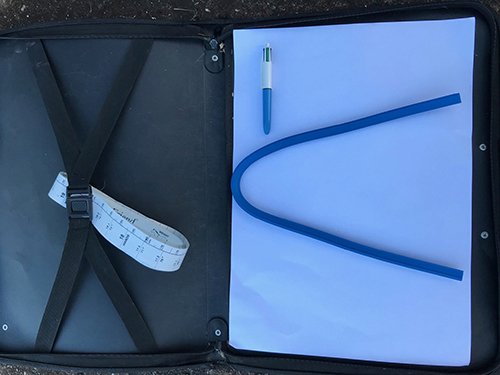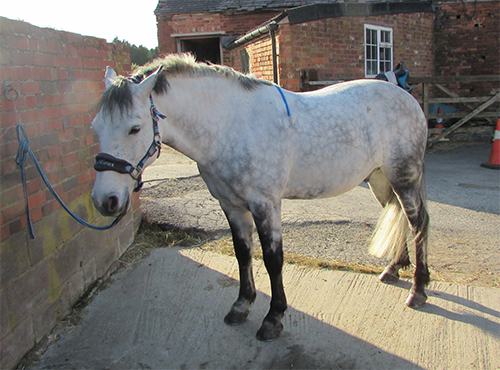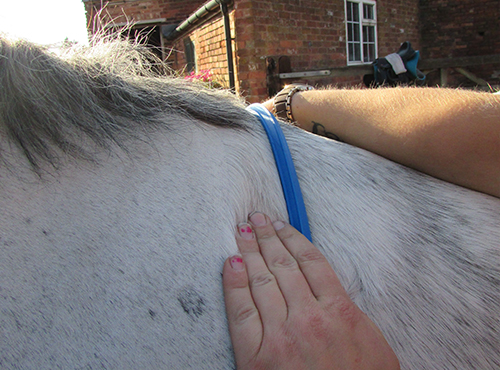Fitting Guide
To help you decide which Discovery saddle is best for you and your horse we would always in the first instance recommend you seek the advice from a qualified saddle fitter. We do understand this is sometimes not possible which is why we have a 14-day return on all saddles and also offer saddle-fitting advice.
A saddle fitting kit can be purchased from us; this includes a template chart and Flexi Curve. Please contact us for details. info@discoverysaddles.co.uk. 01543897260.
Alternatively Flexi curves can be bought from a stationary or art shop. A Flexi curve is used to take a template of your horses back. As we understand saddle fitting is a vey complex subject the advice we give is so you can make a basic assessment of your horses shape. We can advise based on the information supplied but would still recommend where possible you seek the advice from a qualified saddle fitter.


1. Always ensure when you are taking templates of your horse that they are standing square on a level surface.

2. Bend the flexi curve equally in half so you have a ‘V’ Shape. Find the back of the shoulder blade and take a measurement, 3 fingers width (2inches) behind this point.
3. Press down on the curve ensuring the exact shape and then place on a piece of plain white paper and draw round the inside of the curve that was in contact with the horses back. From here you should be able to determine what width your horse will be. This template can be emailed or posted to us or we can email a width-fitting guide. Please call us for some help on 01543 897260 if you think your horse may be difficult to fit as more complex measurements may need to be taken.
Basic Guide to saddle fitting
A Well Fitting Saddle
- The points of the tree run parallel to the horse’s shoulder. These can be located by lifting the saddle flap; sometimes a strap is attached at this point.
- The points of the tree sit behind the horse’s shoulder, not on top of it. As per instruction on taking a template, the point of the tree should sit 3 fingers behind.
- With the rider mounted and without a numnah or pad, there is a minimum of 3 fingers clearance between the underside of the pommel and the top of the horse’s spine. This is an approximate measure and can very between styles of saddle but is useful as a rough guide.
- The saddle tree does not extend past the horse’s last rib (T18) onto the lumbar region.
- The gullet is wide enough so that the panels sit on either side of the spine, not on it.
- The panels should be smooth and symmetrical and follow the contours of the horse’s back to spread the rider’s weight evenly.
- When ridden the saddle should sit evenly either side of the spine with the rider’s weight centred.
- The saddle is stable. It does not bounce excessively or slip to one side.
A Poorly Fitting Saddle
- Your horse may lay ears back when approached with a saddle, or try to nip as he is tacked up.
- Some horses become fidgity when mounting, refuse to stand by mounting block.
- His back may sink suddenly when mounted or rush away from the mounting block.
- Your horse may start rushing over jumps, become strong in the mouth, and be reluctant to jump or canter.
- Bucking is often a sign of pain caused by a badly fitting saddle, as is tail swishing.
- The horses gait may feel slightly uneven, pottery or obviously worse on one of his leads.
- The saddle moves excessively or feels unbalanced when ridden.
Factors that can influence the fit of your saddle
- Repeated mounting from the ground, on the same side can cause the saddle to sit unevenly over time, it may distort the flocking or even twist the tree over time. It is always preferable to use a mounting block.
- Asymmetrical riders or riders with historical injuries may sit more heavily to one side or collapse a hip putting more weight on one side of the saddle. This can cause the saddle to settle unevenly.
- Changes in type, frequency and amount of work the horse is doing.
- Changes in diet, grazing and turnout.
- Changes in weight and size of the rider, the type of rider, the experience of the rider.
- Seasonal weather changes, horses gain condition in the spring and early summer and lose condition in winter.
- Numnahs and pads need to be large enough so that the edging is clear of the saddle at all times, to avoid rubbing or chaffing on the bindings.
- When girthing your saddle it is important to use the best strap position for the horse’s girth line and conformation in order to maintain the balance of the saddle
- Anatomical girths can help when the horse has a particularly forward girth line.
- If you are using an elastic girth, make sure the elastic has 3 layers of elastic thickness, 2 layers rarely provides enough tension when the girth is tightened. Weak or insufficient elastic can pull saddles off centre and such girths are best avoided.
- Uneven stirrup leathers can cause the saddle to pull off to one side, always ensure that stirrup leathers are level and in good repair.
Common Problems Associated With Saddle Fit
The most common reason for excessive movement and bounce at the back of the saddle is panel related. If, as above, the panel is badly flocked, uneven in fit and consistency or over or under flocked the saddle will not conform to the shape of the horse’s back and movement may occur
A saddle can slip for many reasons not related to the saddle itself. A common reason for saddles slipping is hind limb lameness but your vet can only determine this. This may be a route to follow once you have ruled out any unevenness in the panels of the saddle, asymmetry in the horse and also the rider. Turn you saddle over and look along the length of the panel from the front and the rear, ensure each side is level and even in comparison to the other side. Feel along the length of each side to make sure the composition is even, panels can often look even but one side may be flocked softer than the other causing the saddle to tilt to one side when weight is applied. Badly and/or over flocked panels may cause bruising, soft tissue damage, soft lumps, and hair loss from rubbing and other skin related problems for your horse.
- Make sure your stirrup leathers are even – being on the same hole does not mean they are level. It is a good idea to swap sides with your stirrup leathers regularly to minimise difference in length caused by stretch.
- Make sure the tension on the girth straps is even both sides, even if they are on different holes.
- Make sure you have sensible tension on your girth; having the girth too loose often causes a saddle slipping sideways. Check before you mount and after a few minutes of riding.
- Elastic on one end of your girth may cause the saddle to slip sideways, especially on broad horses, always use a girth with elastic either ends or no elastic. Some fatter horses are better not having any elastic at all.
- Some saddles are supplied with a ‘Balance Strap’ (an extra strap behind the conventional centre straps that attaches to the rear of the saddle and comes under the flap at a forward angle). These can be very useful on horses with an uneven gait or conformation. If your saddle does not have balance straps, ask your saddler to assess the saddle for conversion.
- A horse with asymmetrical development or gait may cause the saddle to slip to the side. If all of the above criteria have been met then you may need to further analyse your horses’ musculature and action. Often a horse with mild hind limb lameness will cause the saddle to drop to that side.
- A rider that weights one stirrup more than the other will always cause uneven forces on the saddle and over time will cause the flocking to become uneven. Have somebody watch you ride from the ground to advise whether your posture is correct.
- In the instance of an asymmetrical horse it may be beneficial to use a remedial saddle pad and a combination of shims to correct the balance of the saddle and enable the horse to use his muscles in the correct way.
- Some horse’s conformation is such that they push the saddle forwards even when it is a good fit. This may be because they have a particularly forward girth line and round barrel. In order to prevent your saddle slipping forwards on to the horses shoulder it may be necessary to use point straps. Point straps are girth straps that are attached to the point (front) of the saddletree at each side this allows a better girth alignment and is a proven method for preventing the forward movement of the saddle.
- Consider using a Non-slip Gel or numnah to give the saddle more grip.
- Use quality numnahs and saddlecloths; avoid cheap man-made fabrics, especially those with a shiny, slippery surface.
- Use an anatomical girth. These are designed to angle the girth further back, give more shoulder freedom and are proven to be effective with forward slipping problems.
- Avoid storing your saddle on the common frame type of saddle rack. By sitting your saddle directly onto the frame it will cause the panels to crease, which will distort the pressure immediately behind the shoulder, the most important area of contact in the fit of your saddle. If you do use this type of rack, make sure you use a thick saddle pad or towel between the saddle and the rack to avoid the panels being damaged over time.
- Saddles are better stored on a saddle horse or pole rack.
- Store your saddle in a dry ventilated area so that the leather stays in top condition, and the tree does not warp due to adverse conditions.
- Clean your saddle regularly with a damp cloth and condition the leather with a natural balm or leather food to keep it supple.

